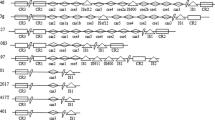Abstract
Typical CRISPR (clustered, regularly interspaced, short palindromic repeat) regions are constituted by short direct repeats (DRs), interspersed with similarly sized non-repetitive spacers, derived from transmissible genetic elements, acquired when the cell is challenged with foreign DNA. The analysis of the structure, in number and nature, of CRISPR spacers is a valuable tool for molecular typing since these loci are polymorphic among strains, originating characteristic signatures. The existence of CRISPR structures in the genome of the members of Mycobacterium tuberculosis complex (MTBC) enabled the development of a genotyping method, based on the analysis of the presence or absence of 43 oligonucleotide spacers separated by conserved DRs. This method, called spoligotyping, consists on PCR amplification of the DR chromosomal region and recognition after hybridization of the spacers that are present. The workflow beneath this methodology implies that the PCR products are brought onto a membrane containing synthetic oligonucleotides that have complementary sequences to the spacer sequences. Lack of hybridization of the PCR products to a specific oligonucleotide sequence indicates absence of the correspondent spacer sequence in the examined strain. Spoligotyping gained great notoriety as a robust identification and typing tool for members of MTBC, enabling multiple epidemiological studies on human and animal tuberculosis.
Access this chapter
Tax calculation will be finalised at checkout
Purchases are for personal use only
Similar content being viewed by others
References
Jansen R, van Embden J, Gaastra WL, Schouls M (2002) Identification of genes that are associated with DNA repeats in prokaryotes. Mol Microbiol 43:1565–1575
Barrangou R, Fremaux C, Deveau H et al (2007) CRISPR provides acquired resistance against viruses in prokaryotes. Science 31: 1709–1712
Deveau H, Garneau JE, Moineau S (2010) CRISPR/Cas system and its role in phage-bacteria interactions. Annu Rev Microbiol 64:475–493
Pourcel C, Salvignol G, Vergnaud G (2005) CRISPR elements in Yersinia pestis acquire new repeats by preferential uptake of bacteriophage DNA, and provide additional tools for evolutionary studies. Microbiology 151: 653–663
Sorek R, Kunin V, Hugenholtz P (2008) CRISPR – a widespread system that provides acquired resistance against phages in bacteria and archaea. Nat Rev Microbiol 6:181–186
Marraffini L, Sontheimer EJ (2010) CRISPR interference: RNA-directed adaptive immunity in bacteria and archaea. Nat Rev Genet 11: 181–190
Groenen PM, Bunschoten AE, van Soolingen D, van Embden JD (1993) Nature of DNA polymorphism in the direct repeat cluster of Mycobacterium tuberculosis; application for strain differentiation by a novel typing method. Mol Microbiol 10:1057–1065
Kamerbeek J, Schouls L et al (1997) Simultaneous detection and strain differentiation of Mycobacterium tuberculosis for diagnosis and epidemiology. J Clin Microbiol 35:907–914
Hoe N, Nakashima K, Grigsby D et al (1999) Rapid molecular genetic subtyping of serotype M1 group A Streptococcus strains. Emerg Infect Dis 5:254–263
Schouls LM, Reulen S, Duim B et al (2003) Comparative genotyping of Campylobacter jejuni by amplified fragment length polymorphism, multilocus sequence typing, and short repeat sequencing: strain diversity, host range, and recombination. J Clin Microbiol 41:15–26
Van Embden JDA, Van Gorkom T, Kremer K, Jansen R et al (2000) Genetic variation and evolutionary origin of the Direct Repeat locus of Mycobacterium tuberculosis complex bacteria. J Bacteriol 182:2393–2401
Caimi K, Romano MI, Alito A et al (2001) Sequence analysis of the direct repeat region in Mycobacterium bovis. J Clin Microbiol 39: 1067–1072
Filliol I, Driscoll JR, Van Soolingen D et al (2003) Snapshot of moving and expanding clones of Mycobacterium tuberculosis and their global distribution assessed by spoligotyping in an international study. J Clin Microbiol 41: 1963–1970
Streicher EM, Victor TC, van der Spuy G et al (2007) Spoligotype signatures in the Mycobacterium tuberculosis complex. J Clin Microbiol 45:237–240
Van Soolingen D (2001) Molecular epidemiology of tuberculosis and other mycobacterial infections: main methodologies and achievements. J Intern Med 249:1–26
Brudey K, Driscoll JR, Rigouts L et al (2006) Mycobacterium tuberculosis complex genetic diversity: mining the fourth international spoligotyping database (SpolDB4) for classification, population genetics and epidemiology. BMC Microbiol 6:23
Intitute Pasteur de la Guadeloupe (1993) Tuberculose et Mycobactéries, Abymes Cedex. http://www.pasteur-guadeloupe.fr/tb/bd_myco.html. Accessed 10 Jan 2014
Mycobacterium bovis spoligotyping Database. http://www.Mbovis.org. Accessed 10 Jan 2014
van der Zanden AGM, Kremer K, Schouls LJ et al (2002) Improvement of differentiation and interpretability of spoligotyping for Mycobacterium tuberculosis complex isolates by introduction of new spacer oligonucleotides. J Clin Microbiol 40:4628–4639
Javed MT, Aranaz A, de Juan L et al (2007) Improvement of spoligotyping with additional spacer sequences for characterization of Mycobacterium bovis and M. caprae isolates from Spain. Tuberculosis 87:437–445
Duarte EL, Domingos M, Amado A, Botelho A (2008) Spoligotype diversity of Mycobacterium bovis and Mycobacterium caprae animal isolates. Vet Microbiol 130:415–421
Rodríguez S, Bezos J, Romero B, de Juan L et al (2011) Mycobacterium caprae infection in livestock and wildlife, Spain. Emerg Infect Dis 17:532–535
Acknowledgments
This work was supported by Fundacão para a Ciência e Tecnologia (FCT) through project PTDC/CVT/117794/2010 and in the framework of Projecto 3599—Promover a Produção Científica e Desenvolvimento Tecnológico e a Constituição de Redes Temáticas.
Author information
Authors and Affiliations
Corresponding author
Editor information
Editors and Affiliations
Rights and permissions
Copyright information
© 2015 Springer Science+Business Media New York
About this protocol
Cite this protocol
Botelho, A., Canto, A., Leão, C., Cunha, M.V. (2015). Clustered Regularly Interspaced Short Palindromic Repeats (CRISPRs) Analysis of Members of the Mycobacterium tuberculosis Complex. In: Cunha, M., Inácio, J. (eds) Veterinary Infection Biology: Molecular Diagnostics and High-Throughput Strategies. Methods in Molecular Biology, vol 1247. Humana Press, New York, NY. https://doi.org/10.1007/978-1-4939-2004-4_27
Download citation
DOI: https://doi.org/10.1007/978-1-4939-2004-4_27
Published:
Publisher Name: Humana Press, New York, NY
Print ISBN: 978-1-4939-2003-7
Online ISBN: 978-1-4939-2004-4
eBook Packages: Springer Protocols




